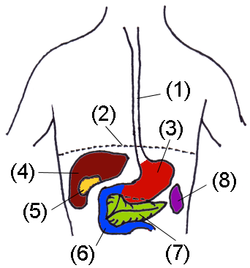| Gall Bladder | |
|---|---|
| Gall bladder is #5 | |
| Diagram of Stomach | |
| Latin | vesica fellea |
| Gray's | subject #250 1197 |
| System | Digestive system (GI Tract) |
| Artery | Cystic artery |
| Vein | Cystic vein |
| Nerve | Celiac ganglia, vagus |
| Precursor | Foregut |
The gallbladder (or cholecyst, sometimes gall bladder) is a small non-vital organ which aids in the digestive process and concentrates bile produced in the liver.
Human anatomy
The gallbladder is a hollow organ that sits in a concavity of the liver known as the gallbladder fossa. In adults, the gallbladder measures approximately 10 cm in length and 4 cm in diameter when fully distended. It is divided into three sections: fundus, body, and neck. The neck tapers and connects to the biliary tree via the cystic duct, which then joins the common hepatic duct to become the common bile duct.
Microscopic anatomy
The different layers of the gallbladder are as follows:
- The gallbladder has a simple columnar epithelial lining characterized by recesses called Aschoff's recesses, which are pouches inside the lining.
- Under the epithelium there is a layer of connective tissue (lamina propria).
- Beneath the connective tissue is a wall of smooth muscle (muscularis externa) that contracts in response to cholecystokinin, a peptide hormone secreted by the duodenum.
- There is essentially no submucosa separating the connective tissue from serosa and adventitia, but there is a thin lining of muscular tissue to prevent infection.
Function
The gallbladder stores about 50 mL (1.7 US fluid ounces / 1.8 Imperial fluid ounces) of bile, which is released when food containing fat enters the digestive tract, stimulating the secretion of cholecystokinin (CCK). The bile, produced in the liver, emulsifies fats and neutralizes acids in partly digested food.
After being stored in the gallbladder the bile becomes more concentrated than when it left the liver, increasing its potency and intensifying its effect on fats. Most digestion occurs in the duodenum.
Vertebrates have gallbladders (except the horse and the rat) while invertebrates do not. This is because vertebrates eat in boluses while invertebrates are constantly eating. To digest a large bolus of food requires a large amount of digestive secretions, hence the presence of a gallbladder.
The human gallbladder is shaped like a grape, although the organ's shape and function vary considerably among other mammalian species; in fact, in some species, such as the lamoids, the gallbladder is absent.
Abnormal conditions
Gallstones may develop in the gallbladder as well as elsewhere in the biliary tract. If gallstones in the gallbladder are symptomatic and cannot be dissolved by medication or broken into small pieces by ultrasonic waves, surgical removal of the gallbladder, known as cholecystectomy, may be indicated.
Other indications for this procedure include porcelain gallbladder and gallbladder cancer.













No comments:
Post a Comment